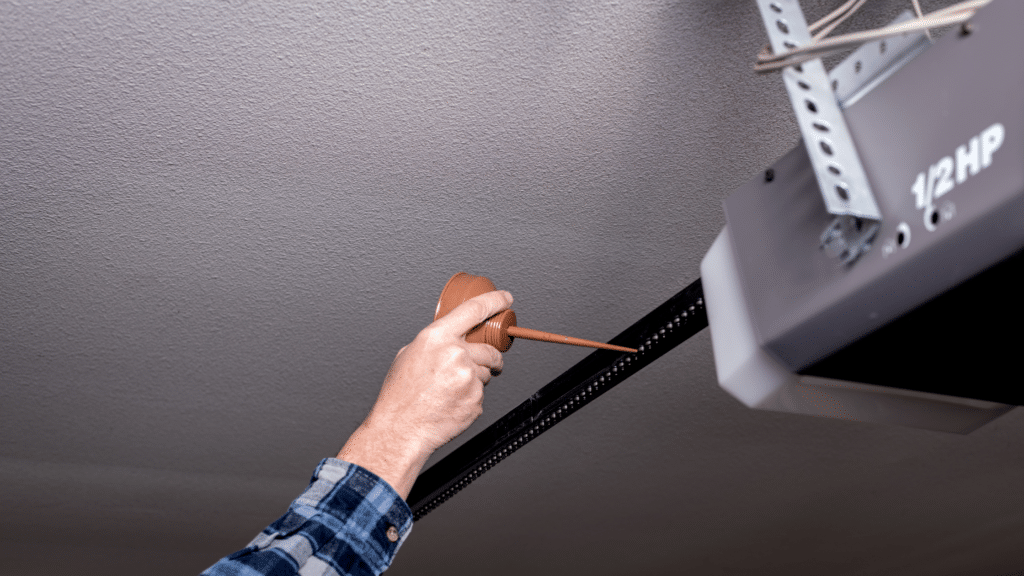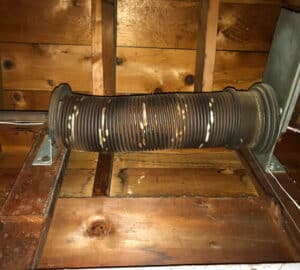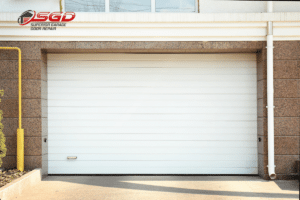Proper maintenance of a garage door plays a crucial role in ensuring its optimal functionality, longevity, and safety. One of the essential tasks that homeowners should perform is lubricating the garage door. In this guide, we will provide comprehensive instructions on how to lubricate your garage door, covering everything from the tools you need to the areas that require lubrication. By following this guide, you can keep your garage door operating smoothly and avoid costly repairs in the future.
Key Takeaways
- Regular lubrication can extend the lifespan of your garage door components.
- Lubrication reduces friction and wear and tear, ensuring smoother operation.
- Garage door rollers, springs, chains, and hinges require regular lubrication.
- Proper lubrication of the garage door opener prevents it from malfunctioning.
- Establishing a regular lubrication schedule is essential for maintaining your garage door’s optimal performance.
Why Lubricating Your Garage Door is Important
Proper lubrication is crucial for keeping your garage door running smoothly. Regular lubrication can help reduce wear and tear on the moving parts of your garage door, prolonging its life. Several components of your garage door require lubrication, including the springs, rollers, hinges, chain or belt, and tracks. Failing to lubricate these parts can cause them to wear out faster, leading to more significant problems over time.
Lubricating your garage door can also minimize noise while it’s opening or closing. If you notice any squeaking or grinding sounds when operating your garage door, it’s likely due for lubrication.
Where to Lubricate Garage Door
It’s essential to lubricate the right areas of your garage door to ensure optimal performance. Here is where to lubricate your garage door:
- Rollers: Apply lubricant to the roller stems while avoiding the wheels’ tracks.
- Springs: Apply lubricant to the springs while avoiding the brackets at the end of the springs.
- Hinges: Apply lubricant to the pivot points of the door hinges.
- Chain or belt: Apply lubricant to the chain or belt of the opener, avoiding the rails.
- Tracks: Apply lubricant to the vertical and horizontal tracks without getting any on the rollers.
The Benefits of Lubricating Your Garage Door
Regular lubrication can offer many benefits, including:
- Minimizing noise
- Reducing wear and tear
- Increase your garage door’s lifespan
- Promote smoother operation
By keeping your garage door lubricated, you’ll ensure it operates smoothly for years to come. In the following sections, we’ll provide a detailed guide on how to lubricate each component of your garage door, the tools you’ll need, and the best practices to make it a more manageable task.
Steps to Prepare for Lubricating Your Garage Door
Before you start lubricating your garage door, it is essential to prepare properly. In this section, we will discuss what tools and supplies you need, the frequency of lubrication, and precautions to take.
What to Use to Lubricate Garage Door
It is crucial to choose the right lubricant for your garage door to achieve optimal results. Don’t use WD-40 or similar products, as they can attract dust and dirt, causing deterioration. Instead, use a silicone-based lubricant, lithium grease, or white lithium grease.
How Often to Lubricate Garage Door
How frequently you lubricate your garage door depends on multiple factors such as usage, location, and environmental conditions. In general, it is recommended to lubricate your garage door at least once a year. If your garage door is used frequently, you may need to lubricate it every six months.
How to Lubricate Garage Door Springs
Garage door springs can be dangerous, and it is crucial to take proper safety measures before lubricating them. We recommend calling a professional for lubricating torsion springs. For extension springs, use a lubricant that can penetrate the coils and apply it to both ends.
Precautions to Take Before Getting Started
Ensure that your garage door is closed, unplug your garage door opener, and disconnect the door from the opener by using the emergency release cord. Check for any damaged or worn parts and make the necessary repairs before lubrication. Wear gloves and protective eyewear to protect your hands and eyes.
Lubricating the Garage Door Rollers
Proper lubrication of the garage door rollers is crucial for smooth operation. Here are the steps to lubricate your rollers:
- Clean the rollers thoroughly to remove any buildup of grime or dirt.
- Apply a generous amount of lubricant to the roller stems, ensuring it reaches the bearings.
- Roll the door up and down a few times to work the lubricant into the bearings evenly.
- Wipe off any excess lubricant with a clean cloth.
The type of lubricant to use depends on your environment and the type of rollers you have. Silicone spray or white lithium grease are popular choices. Be sure to avoid using WD-40 or any other substitutes that can cause damage to your rollers.
Regularly lubricating your garage door rollers can extend their lifespan and avoid costly repairs. We recommend lubricating your rollers every six months or more often depending on how frequently your garage door is used.
Lubricating the Garage Door Springs
Garage door springs are essential components that support the weight of the door and allow it to move smoothly. Over time, these springs can become worn out and need lubrication to function efficiently.
To lubricate the garage door springs, follow these steps:
- Start by cleaning the springs with a dry cloth to remove any debris or dust.
- Apply a high-quality lubricant specifically designed for garage door springs. Be sure to use a lubricant that is silicone-based and not grease-based.
- Lubricate the springs along their entire length, paying special attention to the parts where they contact other components of the garage door system.
- Use a rag to wipe away any excess lubricant, making sure not to leave any residue behind.
One of the most common questions asked is how often you should lubricate your garage door springs. The answer depends on several factors, including the frequency of use and environmental conditions.
As a general rule of thumb, it is recommended to lubricate your garage door springs every six months to one year. However, if you frequently use your garage door, you may need to lubricate it more frequently.
Tip: If you notice any signs of wear and tear on your garage door springs, such as rust or cracking, contact a professional garage door service provider for repair or replacement.
Regularly lubricating your garage door springs can significantly prolong their lifespan and keep your garage door functioning smoothly. Be sure to follow the proper technique when lubricating your garage door springs to ensure optimal results and avoid any damage or safety issues.
lubricate Garage Door Chain or Belt
The garage door chain or belt is a central part of your garage door opener system, and it requires proper maintenance to operate smoothly. Regular lubrication can help minimize noise and friction while extending the lifespan of your opener. Here is a step-by-step guide on how to lubricate your garage door chain or belt:
- First, disconnect the power to the garage door opener to prevent any accidents.
- Locate the chain or belt and carefully clean it using a clean rag to remove any dirt or debris.
- Apply a generous amount of lubricant to the length of the chain or belt using a lubricant spray.
- Let the lubricant sit for a few minutes before wiping off any excess with a cloth.
- Reconnect the power to the garage door opener and test the operation to ensure smooth movement.
For best results, lubricate your garage door chain or belt every six months or as recommended by the manufacturer. Always use a silicone-based lubricant, as it is less likely to attract dirt and debris compared to other types. However, avoid using oils or greases as they can attract dirt and gum up the chain or belt. By following these simple steps, you can help maintain the performance of your garage door opener and prolong its lifespan.
Best Practices for Lubricating Garage Door Hinges
Proper lubrication of garage door hinges is essential for optimal performance. Neglecting this component can result in creaking, sticking, or even damage to the hinges.
The best way to lubricate your garage door hinges is by using a silicone-based lubricant. This type of lubricant is ideal for garage doors because it does not attract dirt, dust, or debris, which can lead to build-up and obstruction.
Before applying lubricant, it is essential to clean the hinges thoroughly to remove any existing dirt or debris. You can use a cloth or a brush to clean the hinges, ensuring that no debris is left behind.
To lubricate the hinges, apply the silicone-based lubricant to the pivot points of each hinge. Use a cloth to remove any excess lubricant and ensure that the lubricant reaches the entire hinge surface for optimal results.
When lubricating, ensure that you do not overdo it, as too much lubrication can lead to build-up, which can also impede proper operation. If you have any doubts, follow the manufacturer’s instructions, and remember to avoid using WD-40 or other oil-based lubricants, which can attract dirt and dust.
Schedule a garage door lubrication session at least twice a year to ensure that your garage door components remain in top-notch condition. By faithfully following these best practices, you’ll keep your garage door functioning flawlessly for years.
How to Lubricate the Garage Door Opener
The garage door opener is a critical component of your garage door that requires regular maintenance to function correctly. By lubricating the opener, you can ensure smooth and quiet operation, reduce wear and tear, and extend its lifespan. Here are the steps to safely lubricate the garage door opener:
Types of Openers
The type of garage door opener you have will dictate the lubrication points and techniques required. The three common types of openers are:
- Chain Drive Opener
- Belt Drive Opener
- Screw Drive Opener
Refer to the manufacturer’s manual or website to determine the type of opener you have.
Lubrication Points
The garage door opener has various moving parts that require lubrication. These include:
- The rail
- The chain or belt
- The arm connector
- The trolley
- The gear and sprocket assembly
Refer to the manufacturer’s manual for specific locations and the recommended type of lubricant.
What Type of Lubricant to Use
It is crucial to use the recommended lubricant for your garage door opener. Using the wrong type of lubricant can cause unnecessary wear and tear and reduce the lifespan of the opener. A silicone-based lubricant is the most common and recommended type of lubricant for garage door openers.
Step-by-Step Guide
- Disconnect the power to the garage door opener.
- Clean the opener’s moving parts using a cloth and a mild cleaner to remove any debris or dirt buildup.
- Apply the recommended lubricant to the designated lubrication points. Avoid over-lubricating the components.
- Operate the garage door opener several times to distribute the lubricant evenly.
- Reconnect the power to the garage door opener.
Remember to repeat this process every 6 to 12 months, depending on the frequency of use and environmental conditions.
Maintaining Garage Door Tracks
Proper lubrication of the garage door tracks is a critical aspect of routine maintenance. By making sure the tracks are well lubricated, you can prevent operational issues and prolong the lifespan of your garage door. Here are the areas that require attention and the recommended ways to lubricate them:
| Part of the Garage Door | Recommended Lubricant |
|---|---|
| Horizontal Track | Spray lithium grease on the inside of the track, where the rollers move. |
| Vertical Track | Apply a small amount of lubricant to the rollers where they come into contact with the track. Avoid using too much lubricant, as this can cause buildup. |
| Bearings | Use white lithium grease on the bearings to ensure smooth operation. |
| Chain or Belt | Add a few drops of lubricant to the chain or belt, depending on your garage door opener type. Refer to Section 6 on how to lubricate garage door opener chains for greater insight into the process. |
Make sure to wipe off any excess lubricant with a clean cloth and regularly inspect the tracks for signs of wear and damage. By following these maintenance tips, you can keep your garage door operating smoothly and prevent costly repairs down the line.
Regular Garage Door Lubrication Schedule
Establishing a regular lubrication schedule is key to ensuring your garage door’s components remain in top condition. By adhering to a consistent lubrication routine, you can prevent breakdowns, reduce friction, and prolong the lifespan of your garage door.
Frequency of Lubrication
How often you lubricate your garage door depends on various factors, such as how frequently you use it and the local environment. As a general rule, your garage door should be lubricated at least once a year. However, if you use it more often, you should lubricate it every six months.
If you live in a dry environment with minimal humidity, you can lubricate your garage door every other year. For those who live in coastal areas or regions with high humidity, lubrication should be done twice a year to prevent rust.
How to Lubricate a Garage Door
Before lubricating your garage door, make sure to clean all components thoroughly to remove any debris. This will ensure that the lubricant is applied evenly and effectively.
When lubricating, focus on the metal moving parts, such as the rollers, hinges, springs, and opener chain or belt. Apply a small amount of lubricant to each part and wipe off any excess with a cloth.
What to Use to Lubricate Your Garage Door
It is essential to use the proper type of lubricant for your garage door. Avoid using oil-based lubricants such as WD-40, as they can attract dirt and debris over time, leading to more issues. Instead, use a silicone-based lubricant or white lithium grease to keep your garage door operating smoothly.
Consult your garage door manufacturer’s manual to determine the specific lubricants recommended for your door’s components.
Conclusion
Properly lubricating your garage door is a crucial maintenance task that should not be overlooked. Not only does it ensure smooth operation, but it also extends the lifespan of your garage door components. Remember to regularly lubricate the rollers, springs, chain or belt, hinges, tracks, and opener for optimal performance.
By following the steps outlined in this article, you can perform this task safely and effectively, avoiding potential injury and costly repairs. It is recommended to establish a regular lubrication schedule and to always use the recommended lubricant for your specific garage door components.
Investing a little time and effort in maintaining your garage door can save you significant expenses and increase the value of your property. We hope this guide has been helpful in providing all the information you need to properly lubricate your garage door and keep it functioning at its best.
FAQ
How often should you lubricate your garage door?
It is recommended to lubricate your garage door at least once a year. However, if you live in an area with extreme weather conditions or if you use your garage door frequently, you may need to lubricate it more frequently, such as every six months.
What parts of the garage door need to be lubricated?
The important parts of the garage door that need to be lubricated include the rollers, hinges, springs, tracks, and the garage door opener chain or belt.
What should I use to lubricate my garage door?
It is best to use a silicone-based lubricant or a garage door-specific lubricant. Avoid using WD-40 or other petroleum-based lubricants as they can attract dust and debris.
How do I lubricate my garage door springs?
To lubricate your garage door springs, start by ensuring the door is fully closed. Use a spray lubricant or a rag with lubricant to apply a thin coat of lubricant on the springs, focusing on the coils and pivot points. Be cautious when working with garage door springs as they are under tension and can be dangerous if mishandled.
How do you lubricate a garage door opener?
To lubricate your garage door opener, start by unplugging the opener from the power source. Apply a small amount of lubricant to the opener chain or belt, focusing on the areas where it comes into contact with the sprockets or pulleys. Wipe off any excess lubricant to prevent drips.
Should you lubricate garage door springs?
Yes, it is important to lubricate your garage door springs. Proper lubrication helps reduce friction, noise, and wear on the springs, which can extend their lifespan and improve the overall performance of your garage door.
How do I lubricate my garage door chain?
To lubricate your garage door chain, first, ensure the garage door is closed. Apply a small amount of lubricant to the chain, keeping the chain moving by manually lifting the door. Continue applying lubricant until the entire chain is coated. Wipe off any excess lubricant.
How do you lubricate a garage door opener chain?
To lubricate a garage door opener chain, start by unplugging the opener from the power source. Apply a small amount of lubricant to the chain, focusing on the areas where it comes into contact with the sprockets or pulleys. Move the chain manually to ensure proper lubrication. Wipe off any excess lubricant.
What do you use to lubricate a garage door?
It is best to use a silicone-based lubricant or a garage door-specific lubricant. These lubricants are designed to withstand the temperature and conditions of garage door operation, ensuring optimal performance and durability of the components.








